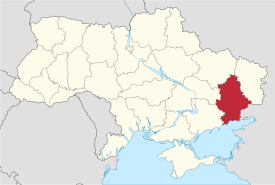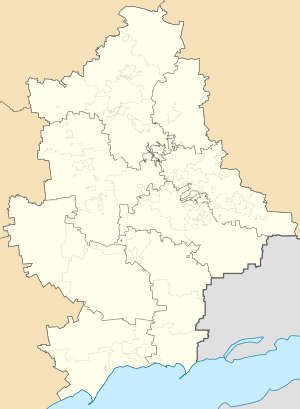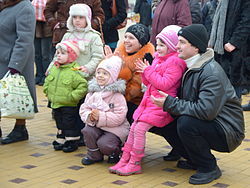
Kyiv Oblast, also called Kyivshchyna, is an oblast (province) in central and northern Ukraine. It surrounds, but does not include, the city of Kyiv, which is administered as a city with special status. However, Kyiv also serves as the administrative center of the oblast. The Kyiv metropolitan area extends out from Kyiv city into parts of the oblast, which is significantly dependent on the urban economy and transportation of Kyiv.

Kharkiv Oblast, also referred to as Kharkivshchyna, is an oblast (province) in eastern Ukraine.

Luhansk Oblast, also referred to as Luhanshchyna (Луганщина), is the easternmost oblast (province) of Ukraine. Its administrative center is the city of Luhansk. The oblast was established in 1938 and bore the name Voroshilovgrad Oblast until 1958 and again from 1970 to 1991. It has a population of 2,102,921.

Zaporizhzhia Oblast, commonly referred to as Zaporizhzhia (Запоріжжя), is an oblast (region) in south-east Ukraine. Its administrative centre is Zaporizhzhia. The oblast covers an area of 27,183 square kilometres (10,495 sq mi), and has a population of 1,638,462.

An oblast in Ukraine, sometimes translated as region or province, is the main type of first-level administrative division of the country. Ukraine's territory is divided into 24 oblasts, as well as one autonomous republic and two cities with special status. Ukraine is a unitary state, thus the oblasts do not have much legal scope of competence other than that which is established in the Ukrainian Constitution and devolved by law. Articles 140–146 of Chapter XI of the constitution deal directly with local authorities and their competence.

Kherson Oblast, also known as Khersonshchyna, is an oblast (province) in southern Ukraine. It is located just north of Crimea. Its administrative center is Kherson, on the northern or right bank of the Dnieper river, which bisects the oblast. The oblast has an area of 28,461 km2 and a population of 1,001,598. It is considered the 'fruit basket' of the country, as much of its agricultural production is dispersed throughout the country, with production peaking during the summer months.

Kramatorsk is a city and the administrative centre of Kramatorsk Raion in Donetsk Oblast, Donbas region of eastern Ukraine. Prior to 2020, Kramatorsk was a city of oblast significance. Since October 2014, Kramatorsk has been the provisional seat of Donetsk Oblast, following the events surrounding the Russo-Ukrainian War's Donbas theater. Its population is 147,145. It is an important industrial and mechanical engineering center in Ukraine. Kramatorsk is on the banks of the Kazennyi Torets River which is a right tributary of the Siverskyi Donets.

Lyman, formerly known as Krasnyi Lyman from 1925 to 2016, is a city in Donetsk Oblast, Ukraine. Until 2016, it also served as the administrative center of Lyman Raion, though administratively it was not part of the raion and incorporated as a city of oblast significance. It still serves as the administrative center of Lyman urban hromada. The population was 20,066, down from 28,172 in 2001.

Administrative divisions development in Ukraine reviews the history of changes in the administrative divisions of Ukraine, in chronological order.

During its existence from 1919 to 1991, the Ukrainian Soviet Socialist Republic consisted of many administrative divisions. Itself part of the highly centralized Soviet Union, sub-national divisions in the Ukrainian SSR were subordinate to higher executive authorities and derived their power from them. Throughout the Ukrainian SSR's history, other national subdivisions were established in the republic, including guberniyas and okrugs, before finally being reorganized into their present structure as oblasts. At the time of the Ukrainian SSR's independence from the Soviet Union, the country was composed of 25 oblasts (provinces) and two cities with special status, Kiev, the capital, and Sevastopol, respectively.

An urban district or urban raion is the second-level administrative division in certain cities in Ukraine. An urban district is subordinate to a city's administration. There are 118 districts in 20 cities across Ukraine. The cities that contain districts are mostly administrative centers in addition to the two cities with special status. The number of city districts per region varies between a minimum of two and a high of 21 in Donetsk Oblast. The maximum districts for a single city in the country is Kyiv, which has 10 districts.

Krasnodon Raion or Sorokyne Raion was a raion (district) in Luhansk Oblast, Ukraine from 1923 to 2020. The administrative center of the raion was Krasnodon, also known as Sorokyne. The last estimate of the raion population before its abolition was 28,943.

From the end of February 2014, in the aftermath of the Euromaidan and the Revolution of Dignity, which resulted in the ousting of Russian-leaning Ukrainian President Viktor Yanukovych, demonstrations by Russian-backed, pro-Russian, and anti-government groups took place in major cities across the eastern and southern regions of Ukraine. The unrest, which was supported by Russian military and intelligence, belongs to the early stages of the Russo-Ukrainian War.
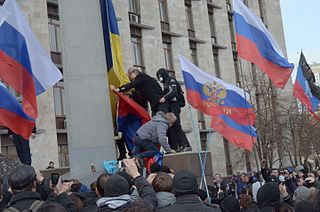
This is a timeline of the 2014 pro-Russian unrest that has erupted in Ukraine, in the aftermath of the Ukrainian revolution and the Euromaidan movement.

The governor of Donetsk Oblast is the head of executive branch for the Donetsk Oblast. Due to the current Russo-Ukrainian War Donetsk Oblast is, since 5 March 2015, assigned as a civil–military administration. Hence the governor of Donetsk Oblast is officially called Head of the Donetsk Regional Military Civil Administration.

Ukraine inherited its special forces (Spetsnaz) units from the remnants of the Soviet armed forces, GRU and KGB units. Ukraine now maintains its own Spetsnaz structure under the control of the Ministry of Internal Affairs and under the Ministry of Defence, while the Security Service of Ukraine maintains its own Spetsnaz force, the Alpha group. In 2016 the Special Operations Forces were created as an independent branch of the Armed Forces of Ukraine formed only by special forces units.

The Donets Railway is a railway in Donbas, Eastern Ukraine. It is one of six rail systems owned and operated by Ukrainian Railways. It is part-owned by the Ukrainian government; Russia has claimed it since the 2014 Russian military intervention in Ukraine. Because of that, only part of the Donetsk Railway is operational. In December 2014, a regional branch of Ukrzaliznytsia Donetsk Railway was created and the headquarters was moved from Donetsk to Lyman.

Vadym Anatoliyovych Troyan is a former Ukrainian government official and military leader. He was the chief of police for the Kyiv Oblast from 2014 to 2021. He was formerly the deputy commander of the Azov Battalion with the rank of colonel.
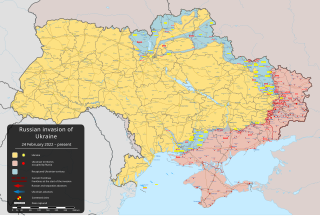
The Russian-occupied territories of Ukraine are areas of Ukraine that are currently controlled by Russia in the course of the Russo-Ukrainian War. In Ukrainian law, they are defined as the "Temporarily occupied territories of Ukraine".

The following outline is provided as an overview of and topical guide to the Russo-Ukrainian War:
